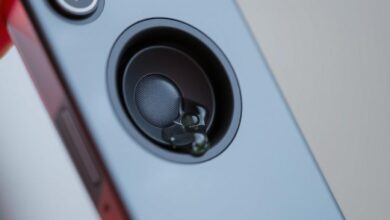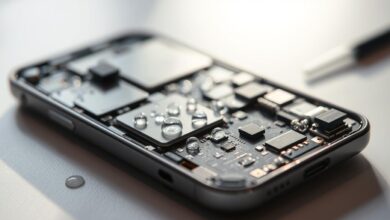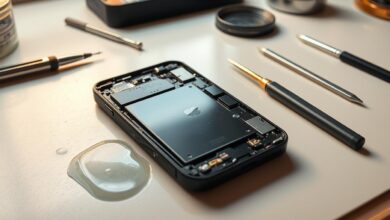how to remove water in iphone
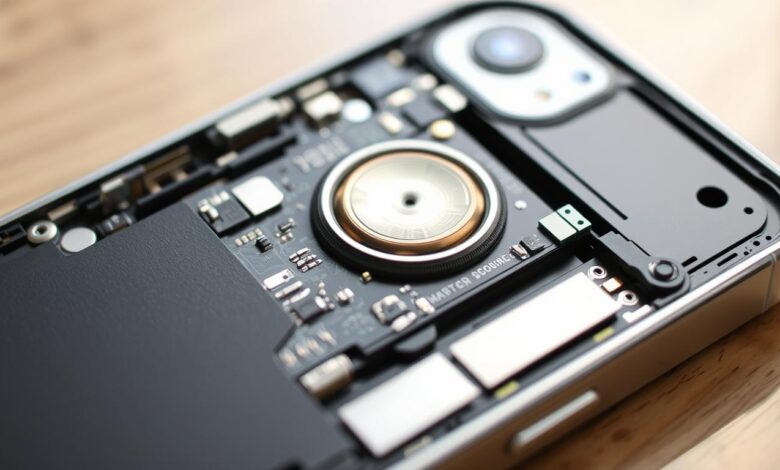
Accidental drops in water or exposure to moisture can be disastrous for your iPhone. If you’ve found yourself in such a situation, it’s essential to act quickly to minimize damage.
I will walk you through the steps to restore your device to its optimal functionality. Understanding the extent of water damage and identifying signs of speaker damage are crucial.
Taking immediate action and using the right methods can make a significant difference in fixing your iPhone’s speaker. In this guide, we’ll explore various techniques to repair your iPhone’s speaker and get your device working like new again.
Key Takeaways
- Understand the signs of water damage and speaker damage
- Learn immediate actions to take after exposure to water
- Discover methods to repair your iPhone’s speaker
- Restore your iPhone to its optimal functionality
- Prevent future damage with the right precautions
Understanding Water Damage in iPhones
It’s important to know how water damage affects iPhones. This knowledge helps prevent problems and keeps your device working well. Water damage can cause minor issues like distorted audio or serious problems that make your iPhone unusable.
When water gets into an iPhone, it can harm many parts. This can lead to malfunctions and even long-term damage.
How Water Affects iPhone Components
Water can damage the iPhone’s internal parts, causing corrosion. This can lead to iphone speaker issues, like distorted or muffled sound. The corrosion can also harm other parts, like the logic board and charging port, causing bigger problems.
The Speaker System: Most Vulnerable to Water
The speaker system is very sensitive to water damage. It’s often exposed to the outside. When water gets in, it can cause iphone speaker sound issues, like distorted sound or poor quality. In bad cases, it can even break the speaker, needing expensive fixes or a new one.
Water Resistance Ratings Across iPhone Models
iPhone models have different levels of water resistance, shown by their IP ratings. Knowing these ratings helps users see how well their device protects against water damage.
IP67 vs. IP68: What These Ratings Mean
The IP67 and IP68 ratings are common for iPhones. They show how well the device resists dust and water. IP67 devices can handle being underwater up to 1 meter for 30 minutes. IP68 devices can stay underwater longer and at deeper depths, depending on the maker’s specs.
For example, some iPhones with IP68 can go up to 4 meters underwater for 30 minutes. It’s key to know your iPhone’s rating to understand its water resistance.
Water Resistance Limitations by Model
Each iPhone model has its own water resistance level. For example, CNET says the iPhone 7 and later have some water resistance. But remember, water resistance is not the same as being waterproof. The resistance level can differ a lot between models.
- iPhone 7 and iPhone 7 Plus: IP67 rating, up to 1 meter for 30 minutes
- iPhone XS and later: IP68 rating, with varying depths and durations
Why Water Resistance Decreases Over Time
Water resistance isn’t permanent and can lessen over time. Normal wear and tear can damage the seals and gaskets that keep your iPhone safe.
Regular use and environmental factors can gradually reduce your iPhone’s water resistance. So, it’s important to be careful with your device’s water exposure and protect it.
Signs Your iPhone Speaker Has Water Damage
Water damage to your iPhone speaker can show up in many ways. It’s important to spot the signs early. When water gets into the speaker, it can mess with the sound quality and how your device works.
Audio Distortion and Muffled Sound
One of the first signs of water damage is audio distortion or muffled sound. If your iPhone’s speaker sounds fuzzy or unclear, water might be the culprit. Water can mess with the speaker’s electrical parts, making the sound off.
Intermittent Speaker Functionality
Another sign is intermittent speaker functionality. You might find that the speaker works sometimes but not others. This can happen because water messes with the speaker’s connections or parts, causing it to act up.
Complete Speaker Failure
In bad cases, water damage can make the speaker stop working completely. If your iPhone speaker just stops, it might be because water has really damaged it inside. You might need to fix or replace it to get sound back.
Spotting these signs early can help prevent more damage. If you see any of these problems, it’s key to follow the right iphone speaker troubleshooting steps. This might help you fix iphone speaker problems.
Immediate Actions When Your iPhone Gets Wet
Water can harm your iPhone, but quick action can help. If your device gets wet, act fast to protect its parts, like the speaker.
Power Off Your Device Immediately
First, turn off your iPhone right away. This stops short circuits that could damage it, including the speaker. Press and hold the sleep/wake button until you see “Slide to Power Off.” Then, slide it to the right. If it’s still working, this helps keep water out of the circuits.
Remove Case and Accessories
Then, take off any case or accessories. This makes drying easier and stops water damage. Carefully remove the case and any attachments, like headphones or cables, to dry them.
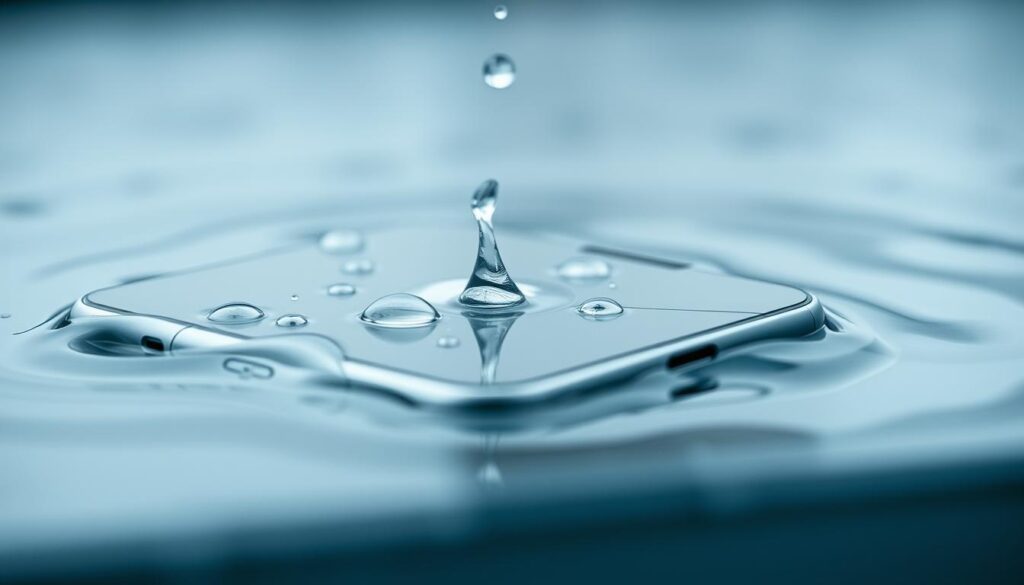
Avoid Common Mistakes
It’s also key to know what not to do. Don’t shake your iPhone or blow into the ports. This can push water deeper into the device. Also, don’t use a hair dryer to dry it, as it can harm the inside. Just dry the outside gently and let it air dry.
If your iphone speaker no sound, quick and right action can help. For more complex problems, like how to fix speaker on iphone, you might need more steps.
Using the Water Eject Feature
To fix your iPhone speaker after it gets wet, try the Water Eject feature. It’s a built-in tool that helps get rid of water from the speaker.
How the Water Eject Feature Works
The Water Eject feature makes a sound that pushes water out of the iPhone’s speaker. It’s great because it might stop you from needing iphone speaker repair. This is because it removes water before it can harm your device.
Step-by-Step Guide to Using Water Eject
To use Water Eject, open the Shortcuts app or a third-party app with this feature. Then, play the Water Eject sound at the loudest volume. You might need to do this a few times to get all the water out.
It’s important to be patient and let it finish. This way, you make sure your iPhone’s speaker is clean and dry.
By following these steps, you can troubleshoot your iPhone speaker. You might even avoid more serious water damage problems.
How to Fix Speaker on iPhone Using Sound Methods
Water damage can mess up your iPhone’s speaker. It might make sounds distorted or muffled. But, sound methods can help get rid of water and fix your iPhone’s sound.
Using Low-Frequency Sounds to Expel Water
Low-frequency sounds can fix your iPhone’s speaker problems. They help push water out of the speaker grills. You can find these sounds online, made just for this purpose.
To use them, play the sound at a good volume for a few minutes. Be patient and repeat it a few times for the best results.
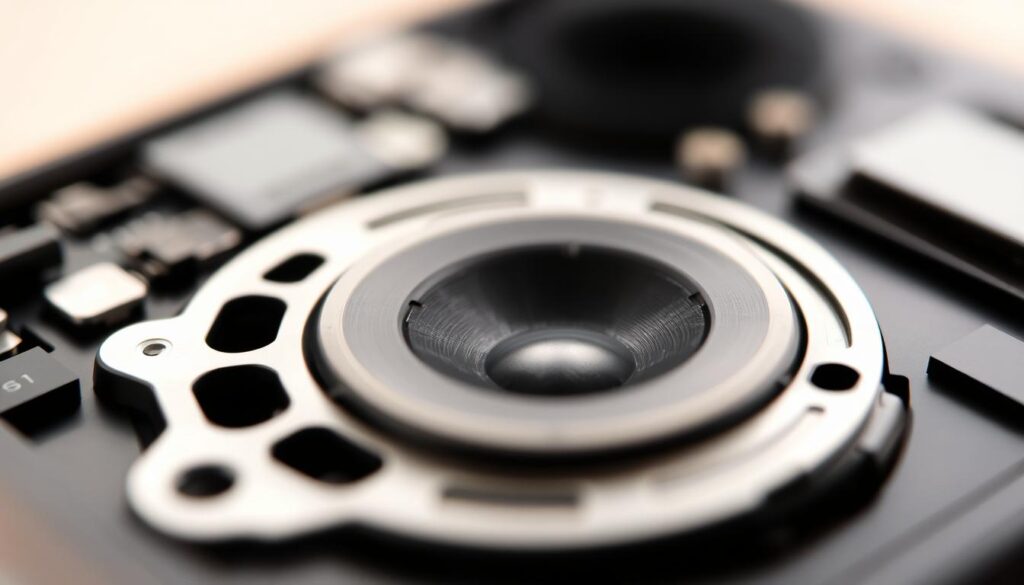
Low-frequency sounds create vibrations that push water out. This method is great for fixing iPhone speaker sound issues caused by water. It might even fix your speaker without needing a pro.
Apps Designed for Water Removal
There are also apps to help remove water from your iPhone’s speaker. Apps like Sound Wave Water Eject and Water Eject for iPhone work by playing sound frequencies. They’re easy to use and can help fix speaker problems caused by water.
Follow the app’s instructions for the best results. Some apps let you adjust the frequency to make them work better. Using these apps is a smart way to fix iPhone speaker sound issues caused by water.
The Manual Removal Method
If your iPhone speaker isn’t working because of water, you can try manual removal. Removing water from the speaker grills might fix the issue. But, you must do it carefully to avoid harming your iPhone.
Safely Removing Water from Speaker Grills
To safely remove water, start by tapping the iPhone gently on a soft surface. Make sure the speaker grill is facing down. This can help get rid of water in the grill. But, don’t tap too hard, as it could push water deeper or damage the speaker.
Inspect the speaker grill for any visible debris or water. If you see any, use a soft, dry cloth to wipe it away. Don’t use sharp objects or abrasive materials, as they could harm the grill.
Using Compressed Air Techniques
Compressed air can also help dry out the speaker grill. Hold the can upright and spray air in short bursts from about 6 inches away. Move the can around the grill to cover it evenly. Be careful not to spray too closely or with too much force, as it could push moisture deeper or damage the speaker.
After using compressed air, check the speaker grill again for moisture. If you still see some, repeat the process until it’s dry. It’s a good idea to test the speaker after each try to make sure you’re not causing more harm.
Drying Techniques: What Actually Works
Water damage to your iPhone’s speaker can be fixed with the right drying methods. We’ll look at these methods in this section. When your iPhone gets wet, it’s important to act fast to lessen damage.
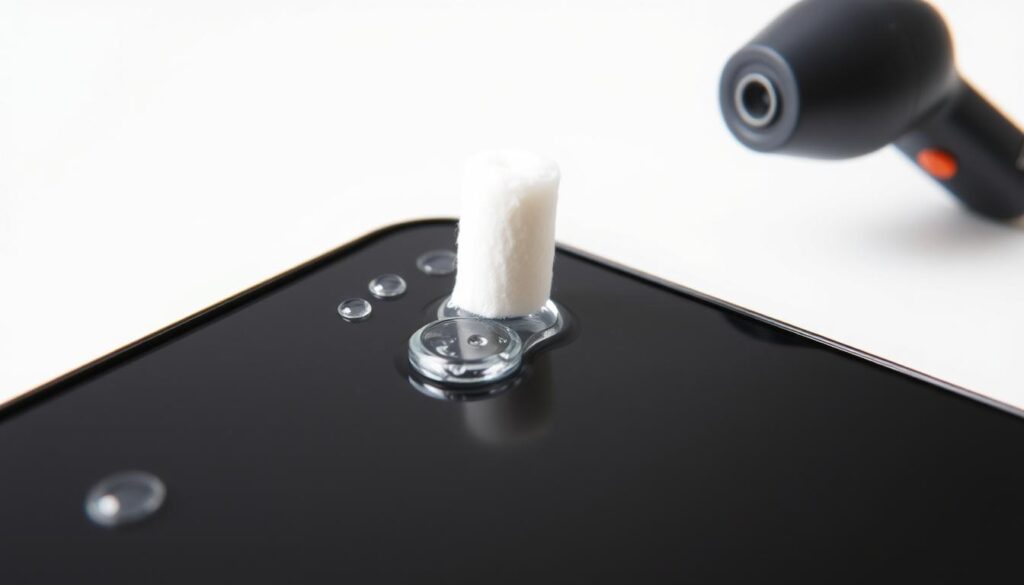
The Rice Method: Fact vs. Fiction
The rice method is a common DIY fix. It involves putting your iPhone in a container of uncooked rice to soak up moisture. But, its success is often questioned. Rice can soak up some moisture, but it’s not always reliable. It can also harm your iPhone if rice gets stuck in its ports.
Silica Gel and Commercial Desiccants
Silica gel packets, found in packaging, are great at pulling out moisture. Commercial desiccants work the same way, made for drying wet electronics. These options are safer than rice because they don’t risk damaging your iPhone with foreign particles.
Scientific Comparison of Drying Methods
Studies show silica gel and commercial desiccants beat the rice method in both effectiveness and safety. Here’s a quick comparison:
| Drying Method | Effectiveness | Safety |
|---|---|---|
| Rice Method | Moderate | Low |
| Silica Gel | High | High |
| Commercial Desiccants | High | High |
Knowing the best drying techniques is key when fixing your iPhone speaker. By picking the right method, you can fix your troubleshoot your iPhone speaker and maybe avoid expensive fixes.
For iphone speaker troubleshooting, being thorough and patient is crucial. Make sure your device is completely dry before trying to use it again.
Advanced Troubleshooting for Persistent Speaker Issues
Dealing with persistent speaker issues on your iPhone can be really frustrating. But, there are advanced steps you can take. If simple fixes don’t work, it’s time to dive into deeper solutions to fix iPhone speaker problems.
Cleaning Speaker Ports and Grills
Dirt and dust in the speaker ports and grills can mess with sound quality. First, turn off your iPhone. Use a soft-bristled brush to carefully remove any visible dirt from the speaker grills. For a deeper clean, compressed air can help, but be careful not to push dirt further into the ports.
For tough dirt, a small amount of isopropyl alcohol on a cotton swab can work. But, make sure not to let any liquid get into the openings. After cleaning, check the speaker ports and grills to make sure they’re clear of debris.
Software Resets and Updates
At times, the problem might be with the software, not the hardware. A software reset can often fix speaker issues. Go to your iPhone’s Settings, then General, and select “Reset.” Choose “Reset all settings” to start. This won’t delete your data but will reset system settings to their defaults.
Also, make sure your iPhone is up to date with the latest software. Go to Settings > General > Software Update to check for updates. Installing the latest iOS version can often fix iPhone speaker problems caused by software bugs.
Testing Speaker Functionality
To figure out if the problem is with the speaker or something else, test the speaker. Play music or a video with clear audio to see if the sound is distorted or coming from the right speaker. You can also use the Voice Memos app to record and play back audio, checking for any distortion.
If the problem still exists, try using headphones. This can help you find out if the issue is with the speaker. If headphones work fine, it might mean you need to consider iphone speaker repair options.
Dealing with Different Types of Liquid Damage
Knowing how different liquids can harm your iPhone is key to fixing it. Liquid damage comes in many forms, each with its own repair needs.
Saltwater vs. Freshwater Damage
Saltwater and freshwater affect your iPhone in different ways. Saltwater is very corrosive because of its salt, which can damage quickly. Freshwater is less corrosive but can still harm your iPhone’s inside parts.
The main difference is how corrosive each liquid is. Saltwater damage needs quick and thorough cleaning to avoid lasting harm. Freshwater damage might be fixed with faster drying methods.
| Liquid Type | Corrosive Potential | Recommended Action |
|---|---|---|
| Saltwater | High | Immediate cleaning and drying |
| Freshwater | Moderate | Quick drying methods |
Sticky Liquids: Coffee, Soda, and Juice
Sticky liquids like coffee, soda, and juice are hard to deal with. They can block speaker grills and ports, leading to ongoing problems if not cleaned right.
It’s important to clean these liquids fast to avoid more damage. Using the right cleaning methods can help fix the issue.
Special Cleaning Techniques for Non-Water Liquids
Non-water liquids need special cleaning. A soft brush or a cotton swab with distilled water can remove sticky residue. Avoid harsh chemicals or rough materials that could harm your iPhone more.
To fix iphone speaker sound issues, make sure the speaker grills are clean. Regular care and quick action when liquids spill can prevent lasting damage.
Preventing Future Water Damage
Preventing water damage is key. It involves using the right accessories and being careful with your iPhone’s water exposure. Water damage can harm your iPhone, especially the speaker. By taking steps to prevent damage, you can avoid problems like an iphone speaker not working or needing to troubleshoot iphone speaker issues.
Waterproof Cases and Accessories
Using waterproof cases and accessories is a great way to protect your iPhone. These items create a barrier against water, lowering damage risks. Choose a waterproof case that fits your iPhone model and has a high water resistance rating, like IP68.
Brands like LifeProof and Catalyst offer top-notch waterproof cases. These cases also protect against dust and other environmental factors. You can also use waterproof pouches and bags for extra protection near water, like at the beach or pool.
| Brand | Water Resistance Rating | Additional Features |
|---|---|---|
| LifeProof | IP68 | Dustproof, Snowproof |
| Catalyst | IP68 | Shockproof, Dustproof |
Everyday Precautions and Best Practices
Using protective accessories is just part of the solution. Everyday precautions can also help a lot. Be careful in places where water is common, like near sinks or during rain. Also, avoid using your iPhone in humid places like bathrooms or gyms.
“The best way to deal with water damage is to prevent it from happening in the first place.” – Expert Advice
Regularly check your iPhone’s ports and openings for debris or dust. This can help keep it water-resistant. By being careful with your iPhone’s environment and following these tips, you can lower the risk of water damage and speaker problems.
Professional Repair Options
When DIY fixes don’t work, it’s time to get professional help. You’ve tried many ways to fix your iPhone’s speaker, but nothing works. Getting help from experts can fix your problem for good.
Apple Store vs. Authorized Service Providers
Apple Stores and authorized service providers use real parts and offer warranty-backed repairs. Going to an Apple Store or authorized service provider means your iPhone gets fixed right. They keep your warranty and quality in check.
Apple Stores are convenient, but authorized service providers might be more flexible. They offer better scheduling and locations.
Check if your iPhone is still under warranty before getting it fixed. If it is, you might get free or discounted repairs.
Third-Party Repair Services: Pros and Cons
Third-party repair services are cheaper but riskier. They’re quick and affordable, but the quality can vary. Some use refurbished or counterfeit parts, which can harm your iPhone.
Before picking a third-party service, research their reputation and read reviews. Make sure they offer a warranty on their work.
Cost Analysis and Insurance Considerations
Repair costs for iPhone speakers vary. Apple Stores or authorized services charge $200 to $300 for out-of-warranty repairs. Third-party services are cheaper, costing $50 to $150. Check if your insurance or AppleCare+ covers the cost.
Consider the cost against the benefits of real parts and warranty-backed services. For many, the peace of mind is worth the extra cost.
When DIY Methods Aren’t Enough
DIY fixes can quickly solve some iPhone speaker problems. But, they can’t handle serious internal damage. Water damage makes things even tougher, needing a deeper look and more complex repairs.
Signs of Serious Internal Damage
Spotting serious damage early can prevent bigger problems. Look out for audio distortion, speakers that work sometimes but not always, or speakers that just stop working. Corrosion on internal parts is a clear sign of damage, usually from too much water.
Water damage can be tricky, and its effects might not show right away. “It’s important to watch your iPhone closely after it gets wet.” If you see odd behavior, get professional help to figure out how bad it is.
Timeframe for Water Damage Repair
How long it takes to fix water damage depends on how bad it is and what DIY steps you’ve tried. Acting fast is key. Getting professional help within 24 to 48 hours can really help.
Experts say,
“The key to fixing water damage is acting quickly and checking the damage right away.”
This shows why you shouldn’t wait to get a pro’s opinion if DIY fixes don’t work.
Conclusion
Fixing your iPhone’s speaker after water damage needs quick action and the right steps. This guide shows how to get your speaker working again. Use the water eject feature, sound-based removal, and manual drying to fix it.
Keeping your iPhone safe from water is key. Use waterproof cases and be careful with liquids. If DIY fixes don’t work, Apple or authorized services can help. Knowing how to fix your iPhone’s speaker saves time and money.
Being proactive helps solve speaker issues and prevents future problems. Regular care and precautions keep your iPhone working well and safe from damage.
FAQ
How do I know if my iPhone speaker has water damage?
If your iPhone speaker sounds distorted or muffled, it might be damaged. Look for crackling or buzzing sounds. Also, check if sound comes from only one speaker.
Can I use any drying method to fix my iPhone speaker?
Not all drying methods work the same. Some, like silica gel, can help. But others, like using rice, are not recommended. They might not work or could damage your phone more.
How do I use the Water Eject feature on my iPhone?
You can access the Water Eject feature through apps or sound frequencies. I’ll show you how to use it to get water out of your iPhone’s speaker.
Can I fix my iPhone speaker using sound methods?
Yes, you can use low-frequency sounds or apps to remove water. These methods can fix your speaker and make it work again.
What should I do immediately after my iPhone gets wet?
Turn off your phone right away. Remove any cases or accessories. Avoid charging it or using heat to dry it. These steps can reduce damage.
How can I prevent future water damage to my iPhone?
Use waterproof cases and accessories. Be careful in wet places. Avoid water or liquids to protect your iPhone.
When should I seek professional help for my iPhone’s water-damaged speaker?
If DIY methods don’t work, or if you see serious damage, get help. Authorized service providers or Apple Stores can fix it.
How do I troubleshoot persistent speaker issues on my iPhone?
Clean the speaker ports and grills. Try software resets and updates. Test the speaker to find and fix the problem.
Can saltwater or other liquids cause more damage to my iPhone’s speaker than freshwater?
Yes, saltwater and liquids like coffee can harm your speaker more. They can corrode or leave sticky residue. Special cleaning is needed for these types of damage.
Are third-party repair services a viable option for fixing my iPhone’s speaker?
Third-party services can be an option. But, consider the cost and reviews first. Authorized services or Apple Stores are usually recommended for a guaranteed fix.
